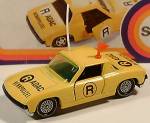 Porsche 911 Cabriolet #0837  Porsche 911 Targa #1010  BMW 2000CS #1011  Citroen DS21 #1014  Mercedes-Benz 280SL #1017  Opel GT 1900 #1018  Lamborghini Espada 400GT #1024  VW 181 #1032 |
Part III: Metal all the way! (For earlier Siku articles, click here) by Remco Natrop The next big change for Sieper Werke began in 1974. All the administration had always been done by hand but now became automated. It was found better to keep track of production numbers, offset and price ranges this way. The Ludenscheid factory was updated with new automatic paint installations (all metal V series are spray-painted by hand!). By 1975 Sieper Werke introduced their new models which were now categorized based on the new 4-digit price system. This is the start of the so-called 'Super Series' also known as '1000's Series'. The four digits of the identification numbers are composed of two sets of two digits: two for the price range the model is in, and two for the model number. I.e. model number 11 in price range 13 would be 1311. Sieper Werke uses the following price ranges based on production costs ('Club Series' are not discussed here!): 08 Convertibles or Cabriolets Sieper Werke decided to change the scale of their models from 1:60 to 1:55 to incorporate more details. The first models in the new series were old 'V series' casts, which received a new identification number. All new casts were in 1:55 scale, in which they still are today with the exception of the 'Club Series' models introduced in 1990 and marketed as 'Super Series' since 1993. But the scale was not the only thing that changed; Siku models became more and more recognizable due to the new plastic wheels with white 5-spoke and later wire print and the new box types they came in. Also the company introduced their first official trademarked logo: the Siku name in a white disc surrounded by three colored rings. The first passenger cars were offered in cardboard boxes, while the larger models like vans and trucks were packaged in cardboard boxes with clear plastic windows. By 1979 all the passenger car models were packaged in the blister packages which are still in use today. In 1986 part of the Ludenscheid factory was rebuilt, as a result of a large fire, and updated with the latest technology. All the models were still produced here until 1990 when the 'Club Series' of 75mm models were introduced. The production of the 'Club Series' as well as the passenger cars in the 'Super Series' was gradually moved to the new Hong Kong based factory. All the larger models are still produced in Ludenscheid, Germany. Sieper Werke is still owned by the Sieper family and has been a family business since the 1920's. Sieper Werke used their philosophy "Kids want to play with what
their parents drive" in the 'Super Series' and produced many popular
German |
 VW Golf Cabriolet #1039  Audi 200 5T # 1041  Ford Escort GL # 1048  Chevrolet Camaro Z28 #1051  Chevrolet Corvette #1055  Porsche 911 Turbo #1059  Mercedes-Benz 300TE #1064  BMW 735iL #1070  Mercedes-Benz SSK #1074 |
 cars like the VW Beetle, Golf, Passat and Transporter, the
Opel Kadett and Senator, the Porsche 911 and 928 and many Mercedes Benz
models. Besides these German hits there were also some less popular cars
done like the Lamborghini Espada 400 GT and the Alfa Romeo Montreal. And
for those interested in heavy material there is also wide variety of trucks,
tractors and excavation equipment available (their Faun heavy crane is still
in production after 24 years!).
cars like the VW Beetle, Golf, Passat and Transporter, the
Opel Kadett and Senator, the Porsche 911 and 928 and many Mercedes Benz
models. Besides these German hits there were also some less popular cars
done like the Lamborghini Espada 400 GT and the Alfa Romeo Montreal. And
for those interested in heavy material there is also wide variety of trucks,
tractors and excavation equipment available (their Faun heavy crane is still
in production after 24 years!).